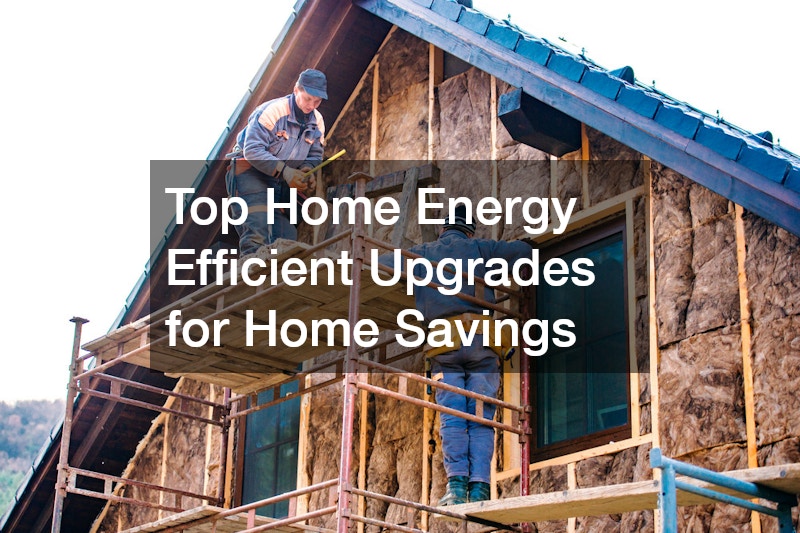In this article, we explore the most effective home energy efficient upgrades for home savings. With the growing emphasis on sustainability and cost efficiency, understanding these upgrades is vital for any homeowner.
How Can Insulation Improve Energy Efficiency?
Understanding Different Types of Insulation
The right type of insulation is crucial in maintaining a home’s energy efficiency. Materials like fiberglass, foam, and cellulose each offer unique benefits and effectiveness levels when it comes to maintaining internal temperatures.
Fiberglass insulation is widely used due to its affordability and easy installation. Foam, on the other hand, provides superior air sealing capabilities, which can significantly enhance a home’s energy performance. Cellulose, an eco-friendly option made from recycled paper products, offers an excellent barrier against air infiltration. Depending on your home’s specific needs, selecting the right insulation can prevent heat loss and reduce energy bills.
The Benefits of Proper Insulation Installation
Proper installation of insulation is as vital as selecting the right type. Poor installation can lead to gaps and voids, which essentially nullify the benefits of insulation by allowing air exchange. Professionally installed insulation ensures a perfect fit and optimal performance, maximizing energy savings. It’s crucial to hire an experienced installer to assess and implement the best solutions tailored to your home. This strategic approach results in a comfortable home environment throughout the year, reducing the reliance on heating and cooling systems. Studies reveal that properly installed insulation can reduce heating and cooling costs by up to 20%.
What Are the Advantages of Energy Efficient Windows?
Features of Energy Efficient Windows
Energy efficient windows are designed with features like double glazing, low-E coatings, and thermal breaks to enhance insulation. Double glazing involves two glass panes with a gap in between to prevent heat transfer. Low-E (low-emissivity) coatings further augment a window’s energy efficiency by reflecting infrared light and keeping heat inside during the winter and outside in the summer. Thermal breaks within the window frame help minimize temperature transfer, facilitating better insulation. These features collectively contribute to reduced energy consumption for heating and cooling. As a result, a home with energy efficient windows can maintain a more consistent temperature all year round.
Cost-Benefit Analysis of Window Upgrades
Initial investments in energy efficient windows can be substantial, yet the long-term savings often justify the costs. By reducing the need for heating and cooling, such windows can lead to significant reductions in energy bills. Homeowners can typically expect a return on investment through lower utility bills, often within several years of installation. Furthermore, government incentives and rebates can further offset these upfront costs. The enhanced comfort and increased property value associated with new, efficient window installations also add to their attractiveness. Therefore, homeowners who invest in such upgrades stand to reap economic and environmental benefits.
Why Should You Consider Upgrading to Smart Thermostats?
How Smart Thermostats Enhance Energy Savings
Smart thermostats are pivotal in optimizing home energy efficiency with features like programmable settings and learning algorithms. These devices adapt to a homeowner’s schedule, learning when to adjust temperatures based on usage patterns. This tailored approach ensures that heating and cooling systems are only active when necessary, curbing unnecessary energy expenditure. It’s estimated that smart thermostats can save users up to 10-12% on heating and 15% on cooling bills. Features like remote access through smartphone apps make it convenient for homeowners to manage their energy use from anywhere. This level of control allows for responsive adjustments based on unexpected schedule changes.
Choosing the Right Smart Thermostat for Your Home
Selecting the right smart thermostat involves considering compatibility with existing HVAC systems and individual needs. Some models offer integration with smart home systems, enhancing overall home automation. Features such as room-specific temperature control and energy usage reports can further optimize savings. It’s essential to evaluate your home’s specific requirements and choose a device that complements your lifestyle.
What Role Do Solar Panels Play in Energy Efficiency?
Harnessing Solar Power for Energy Savings
Solar panels are a revolutionary way to harness renewable energy from the sun and significantly reduce reliance on traditional energy sources. Photovoltaic cells in the panels convert sunlight into electricity, supplying power directly to a home. This clean energy alternative not only cuts electricity costs but also reduces a home’s carbon footprint. By generating power on-site, homeowners can reduce their dependency on the grid, especially during peak hours.
Evaluating the Financial Impact of Solar Panel Installation
While the initial costs of solar panel installation can be high, numerous financial incentives make them more accessible. Tax credits and rebates can significantly lower the out-of-pocket expenses. Over time, the savings on utility bills can lead to a complete return on investment, with many systems paying for themselves in 5 to 10 years. Additionally, solar panels can increase a home’s resale value, making them a sound financial investment.
How Does LED Lighting Contribute to Home Energy Efficiency?
Benefits of Switching to LED Lighting
LED lighting represents a major advancement in energy efficiency and longevity compared to traditional incandescent bulbs. LEDs consume significantly less energy, using up to 75% less power, which can considerably lower energy costs. Additionally, LEDs have a much longer lifespan, often lasting up to 25,000 hours or more, reducing the frequency and cost of replacements. The durability and varied designs of LED lights make them suitable for various home applications.
Calculating Savings from LED Lighting Solutions
Transitioning to LED lighting results in notable energy cost reductions, which can be calculated using specific methods. Assessing the wattage difference between existing bulbs and their LED counterparts helps estimate savings. Considering factors such as usage duration and the number of bulbs replaced further clarifies their financial benefits. Most households can recover the upfront costs of LEDs within a year or two through energy savings.
.





